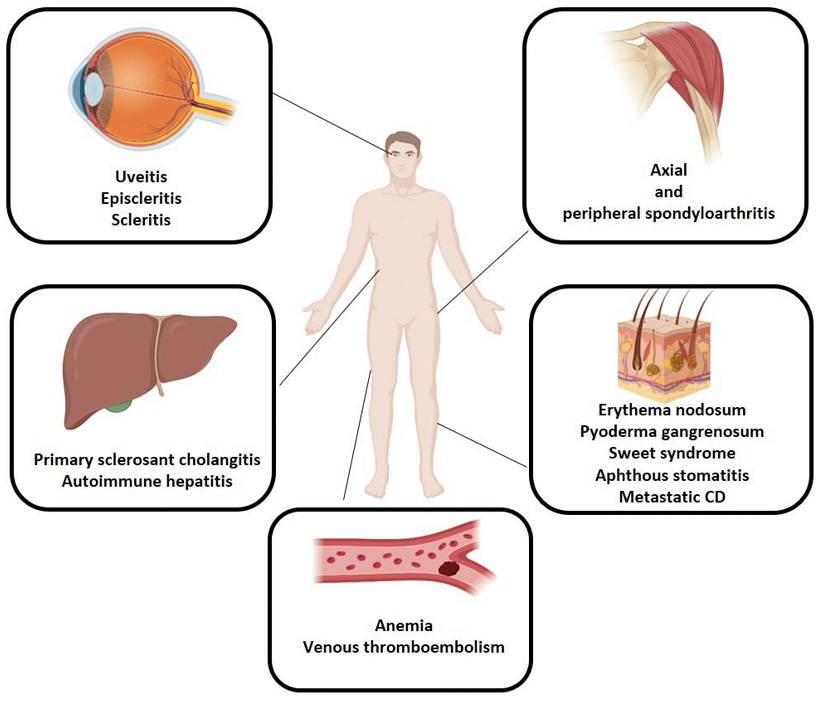Understanding the impact of inflammatory bowel disease beyond the gut-extraintestinal manifestations
Nikhil Prasad Fact checked by:Thailand Medical News Team Aug 28, 2024 7 months, 4 weeks, 1 day, 6 hours, 29 minutes ago
Inflammatory Bowel Disease (IBD) is commonly associated with gastrointestinal symptoms, but it’s important to recognize that the condition can affect various other parts of the body. This
Medical News report explores the extraintestinal manifestations (EIMs) of IBD, which can significantly impact the quality of life for those suffering from the condition. These manifestations, which can involve the joints, skin, eyes, and liver, are frequently overlooked but are crucial in the comprehensive management of IBD.
 Main extraintestinal manifestations observed in patients with inflammatory bowel disease.
What are Extraintestinal Manifestations?
Main extraintestinal manifestations observed in patients with inflammatory bowel disease.
What are Extraintestinal Manifestations?
Extraintestinal manifestations refer to the symptoms and conditions that occur outside of the gastrointestinal tract but are related to IBD. These manifestations can develop in up to 50% of IBD patients at some point in their lives. The institutions involved in the research, including the Department of Gastroenterology and Endoscopy at IRCCS San Raffaele Hospital and Vita-Salute San Raffaele University in Milan, Italy, emphasize the need for awareness and early intervention to manage these conditions effectively.
The study highlights that while gastrointestinal symptoms are the primary focus for many, understanding and addressing EIMs is essential for improving the overall quality of life for IBD patients. The researchers explain that EIMs can affect various systems in the body, including the musculoskeletal, cutaneous, ocular, and hepatobiliary systems. They note that these manifestations are not merely complications but are often integral to the disease process itself.
Musculoskeletal Manifestations
Arthritis is one of the most common EIMs, affecting both axial (spine-related) and peripheral (limb-related) joints. The article details that axial spondyloarthritis (axSpA) and peripheral spondyloarthritis (pSpA) can occur independently of intestinal inflammation, making them particularly challenging to manage. AxSpA is often characterized by back pain and stiffness, which typically worsens in the morning. In contrast, pSpA usually affects the limbs, with symptoms varying widely among individuals.
Interestingly, the study notes that the prevalence of these conditions is higher in Crohn’s Disease (CD) patients compared to those with Ulcerative Colitis (UC), particularly when the colon is involved. This information underscores the need for a tailored approach in managing IBD, taking into account the different types of EIMs that may arise.
Cutaneous Manifestations
Skin-related EIMs are also prevalent, with conditions like erythema nodosum (EN) and pyoderma gangrenosum (PG) being the most common. EN presents as red, tender nodules, usually on the legs, and is often associated with active IBD flares. The article emphasizes that while EN is usually self-limiting, it can be a sign of more severe underlying IBD activity.
PG, on the other hand, is a more serious condition that can lead to large, painful ulcers. The researchers point out that PG may not always correlate with the severity of intestinal diseas
e, making it a particularly challenging manifestation to manage. Treatments often involve systemic steroids or biologic agents like anti-TNF drugs, which can help control both the skin symptoms and the underlying IBD.
Ocular Manifestations
Ocular complications are another significant concern for IBD patients. The article explains that uveitis, episcleritis, and scleritis are among the most common eye-related EIMs. Uveitis, an inflammation of the uvea (the middle layer of the eye), can lead to severe complications if not treated promptly. The study highlights the importance of early detection and treatment, as untreated uveitis can result in permanent vision loss.
Episcleritis and scleritis, though less severe, can still cause significant discomfort and require specialized treatment. The researchers recommend that IBD patients with any signs of ocular involvement seek immediate consultation with an ophthalmologist to prevent long-term damage.
Hepatobiliary Manifestations
The liver and bile ducts can also be affected by IBD. Primary sclerosing cholangitis (PSC) is a condition characterized by inflammation and scarring of the bile ducts, which can lead to liver failure. The study notes that PSC is more commonly associated with UC and that patients with both PSC and IBD are at a significantly increased risk of developing colorectal cancer.
The management of PSC is complex, often requiring regular monitoring and, in severe cases, liver transplantation. The study stresses the importance of early detection and intervention to prevent the progression of liver disease in IBD patients.
Managing Extraintestinal Manifestations
Managing EIMs requires a multidisciplinary approach, involving gastroenterologists, dermatologists, rheumatologists, and ophthalmologists. The article highlights that treatment often involves the same biologic therapies used for managing IBD, such as anti-TNF agents, which are effective in controlling a wide range of EIMs.
However, the researchers also cautions that some of these treatments can have paradoxical effects, potentially worsening certain conditions. For example, anti-TNF therapy, while effective for treating skin manifestations, can sometimes lead to the development of psoriasis-like lesions. The researchers stress the importance of closely monitoring patients on these therapies and adjusting treatment plans as needed.
Conclusion
In conclusion, EIMs are a significant aspect of IBD that requires careful consideration and management. The research emphasizes the need for a comprehensive approach that addresses both the gastrointestinal and extraintestinal aspects of the disease. As this article illustrates, early detection and multidisciplinary care are key to improving outcomes for IBD patients with EIMs.
The study findings were published in the peer-reviewed journal: Biomedicines.
https://www.mdpi.com/2227-9059/12/8/1839
For the latest on IBD, keep on logging to Thailand
Medical News.
Read Also:
https://www.thailandmedical.news/news/study-finds-that-sars-cov-2-is-triggering-new-onset-of-inflammatory-bowel-diseases-in-children
https://www.thailandmedical.news/news/traditional-chinese-medicine-formula-shows-promise-for-treating-inflammatory-bowel-disease
https://www.thailandmedical.news/news/the-probiotic-lacticaseibacillus-casei-ib1-can-help-combat-inflammatory-bowel-disease 